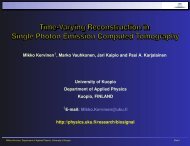USER'S GUIDE - Biosignal Analysis and Medical Imaging Group
USER'S GUIDE - Biosignal Analysis and Medical Imaging Group
USER'S GUIDE - Biosignal Analysis and Medical Imaging Group
- No tags were found...
You also want an ePaper? Increase the reach of your titles
YUMPU automatically turns print PDFs into web optimized ePapers that Google loves.
4.2. The user interface 34required details corresponding to your data file• Number of header lines• Column separator (tab/space, comma, or semicolon)• Data type (ECG or RR)• Data column (the ordinal number of data column)• Data units (μV, V or mV for ECG / ms or s for RR)• Time index column (the ordinal number of time indexes)• Time units (units of time indexes in ms or s)• ECG sampling rate in Hz (if no time index column defined for ECG).Once you have specified the above values for your file, press OK to proceed to analysis.4.2 The user interfaceThe developed HRV analysis software is operated with a graphical user interface whichconsists of only one window. This user interface window is shown in Fig. 4.2. The userinterface is divided into four segments: 1) the RR interval series options segment on thetop left corner, 2) the data browser segment on the top right corner, 3) the analysis optionssegment on the bottom left corner, <strong>and</strong> 4) the results view segment on the bottom rightcorner. Each of these segments are described in Sections 4.2.1, 4.2.2, 4.2.3, <strong>and</strong> 4.2.4,respectively.4.2.1 RR interval series optionsThe RR interval series options shown in Fig. 4.3 include three functions: Artifact correction,Samples for analysis, <strong>and</strong>Remove trend components. The artifact correction options can beused to correct artifacts from a corrupted RR interval series. The user can select betweenvery low, low, medium, strong, <strong>and</strong> very strong correction levels. In addition, a custom levelin seconds can be set. The corrections to be made on the RR series are displayed on theRR interval axis. To make the corrections press the Apply button. A piecewise cubic splineinterpolation method is used in the corrections. You can reverse the correction by pressingthe Undo button or by selecting none as the correction level. It should be noted that artifactcorrection generates missing or corrupted values into the RR series by interpolation <strong>and</strong> can,thus, cause distortion into the analysis results. If ECG is measured, the corrections shouldalways be done by editing the R-peak marks in the ECG data as described in Section 4.2.2.In the Samples for analysis options the part(s) of the RR interval series to be analyzedcan be selected by editing the Number of samples, Range, End, <strong>and</strong> Length values. If morethan one sample is selected the analysis can be done either for the single samples separatelyor by merging the samples into one before analysis. This selection is visible under the RRseries axis when multiple samples are selected. The range of the samples can also be changedby moving/resizing the patch over the RR series as described in Section 4.2.2.Sometimes the RR interval time series includes a disturbing low frequency baseline trendcomponent. Detrending options can be used to remove this kind of trend components.Detrending options include removal of the first, second, or third order linear trend or theKubios HRV <strong>Analysis</strong>version 2.0 beta<strong>Biosignal</strong> <strong>Analysis</strong> <strong>and</strong> <strong>Medical</strong> <strong>Imaging</strong> <strong>Group</strong>Department of PhysicsUniversity of Kuopio, FINLAND





